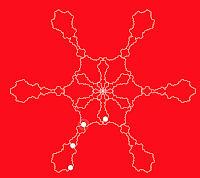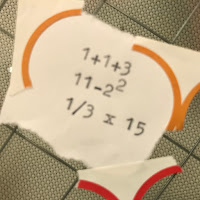180 is a pretty amazing math number. 18 divisors, more than any smaller number. 18 divisors also makes it refactorable, divisible by the Very abundant, as you might guess. Harshad (or Niven) also, divisible by the sum of its digits. The sum of two squares (both squares of divisors!) For Euler's totient function,
Of course, 180 is probably most famous in math for being the sum of the angles in a triangle, or have the degrees of a full turn. How would you prove the triangle relation? (I tell my math history students that is one of the few theorems every math major should be able to prove.)Chris Luzniak read a book that made him realize he needs Math Therapy. Chris is hosts Debate Math podcast with Rob Baier. I loved their episode on comparing teaching reading and math with married couple Courtney and Ryan Flessner.
Denise Gaskins, the home and creator of this here blog carnival, had a math journaling post with three elementary math games. Also don't miss her Math Game Mondays.
Ann Elise Record shared a great padlet of math games. It includes a link to her podcast, discussing meaningful math games with Dr. Nicki Newton.
Rachel Lambert shared the start of some research into mathematical games and their use with teachers. Really exciting and I can't wait to see where it goes!
Howie Hua, modern master of math memes, had the fun Tom and Jerry meme above show up in a reddit Explain the Joke thread. Speaking of Howie, this Star Wars math made me think of another of his memes.
Chalkdust, one of my favorite math periodicals, had an article looking at the discrete math underlying Sudoku. (While you're there, be sure to check out Dear Dirichlet, the funniest mathiest advice column ever.)
One of the great math events this spring has been showings of Counted Out, a documentary examining the importance of math and math education in modern life, centering the work of Robert Moses. Here you can read more about the movie and the people featured. I have never had a stronger endorsement for an education documentary.
The delight of March for me was Ayliean MacDonald's Math Art March.
One idea I tried out for Math Art March was a pattern themed Exquisite Corpse game. This is an art game where you fold a paper and each subsequent artist can only see the very end of the previous artist's work, and draws off of that.
Jenna Laib writes about Anderson's Endless Zeroes, an elementary math investigation into a unit conversion problem.
Daniel Scher created a sweet dynamic applet to use sliding rulers to think about integer addition and subtraction.
 I was pretty happy with this Escherized version of a hexagon dissection I saw. Play yourself in GeoGebra.
I was pretty happy with this Escherized version of a hexagon dissection I saw. Play yourself in GeoGebra.
I've just started on these, but Arula Ratnakar writes mathematical fiction at ClarkesWorld.
The two most recent math books I'm most excited about were The Five Sides of Marjorie Rice, about one of my favorite mathematicians, and How Did You Count?, another great Christopher Danielson book that makes the reader the mathematician.
We'll close with the math blog-o-sphere's most reliable writer, Dylan Kane, who took a break from deep thinking about learning and teaching to share a fun folding problem from Play With Your Math.
Sorry again this was so delayed! If you're interested in hosting the Playful Math Carnival, give it a go! Share what you've loved. The previous was at Denise's Let's Play Math, and the next might also be Denise.
Coming up on my blog this month will be two elementary math and art activities, and some great new math games from my senior seminar.
To close, I think I have to share one of the Star Wars Standards of Mathematical Practice memes that Dave Coffey got us making a few years ago.


























































